Highlighted Genera in Longwood’s Orchid Collection
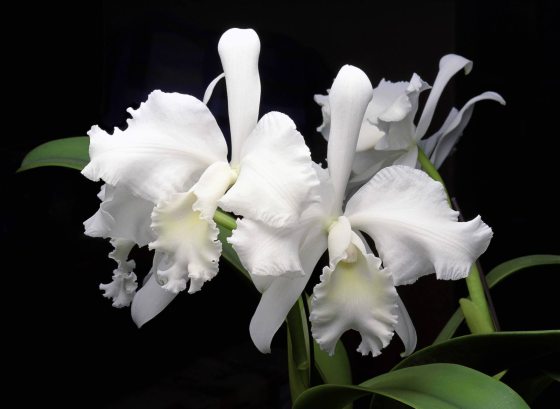
Cattleya (Cattleya Alice B. du Pont)
A favorite of Alice B. du Pont’s, Cattleya, commonly known as the “corsage orchid,” are native to Central and South America. Our storied collection includes antique hybrid and cultivar selections from the first half of the 20th century, many of which are no longer available commercially. With the potential to live forever, some of our Cattleya are surpassing 100 years in age, and will continue to be here for decades to come.
Collection status: limited breeding; 40% of collection
Light: high (3000–5000 footcandles)
Temperature: warm (60–80 F)
Water: dry
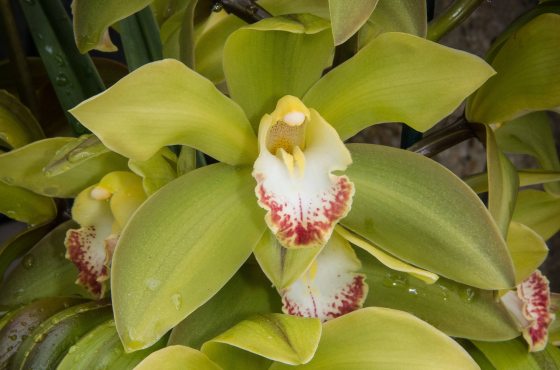
Cymbidium (Cymbidium Nandi ‘Green Giant’)
Cymbidium, natives of Asia, are easily identified by grassy leaves and tall stems with large, colorful flowers. Cymbidium are both terrestrial and epiphytic. The more common cool-flowering Cymbidium require cool winters to initiate blooming and are often used as cut stems in flower arrangements. Warm-growing Cymbidium flower in the summer and reward growers with showy blooms that can last for up to two months.
Collection status: representing the best hybrids of every color
Light: medium to high (2500–5000 footcandles)
Temperature: warm (60–85 F), warm with cold winter [60–85 F, 45–60 F]
Water: evenly moist
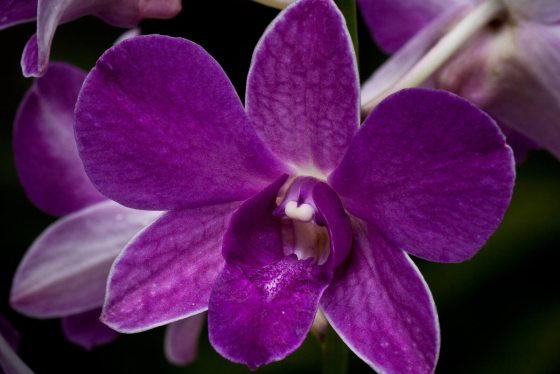
Dendrobium (Dendrobium Burana Blue Sapphire)
A large genus of orchids with more than 1,000 species, Dendrobium is stunningly diverse, ranging from cool-growing miniatures to warmth-loving giants that grow to more than 10 feet tall. Dendrobium are epiphytic plants often found growing on rocks or trees. A group of Dendrobium hybrids called den-phals are the most common cut-flower orchid, due to their long-lasting flowers and their ability to flower multiple times over several years on the same pseudobulb, or swollen stem.
Collection status: 5% of collection; includes many major species and hybrids
Light: low to high (1000–5000 footcandles)
Temperature: cool to warm (50–75 F) (60–85 F)
Water: intermediate
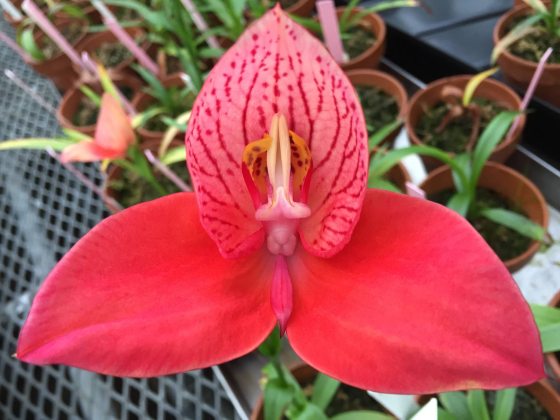
Disa (Disa Longwood Dawning Ever New)
Disa is a unique genus of orchids native to South Africa that arrived at Longwood Gardens in 1963. We were the first institution in the United States to flower Disa uniflora successfully and today we are one of a small number of public gardens around the world who breed and display this genus. Disa uniflora is a terrestrial orchid that thrives in wet conditions. In 2020, Longwood registered three new Disa hybrids, each of which brings with it new and valuable traits, such as Disa Longwood Dawning Ever New, which anchored the genes for a pink and red bicolor flower.
Collection status: actively breeding; 10% of collection (400 adult plants, 700 young plants, and more than 1,000 seedlings)
Light: high (3000–5000 footcandles)
Temperature: cool (50–70 F)
Water: evenly moist
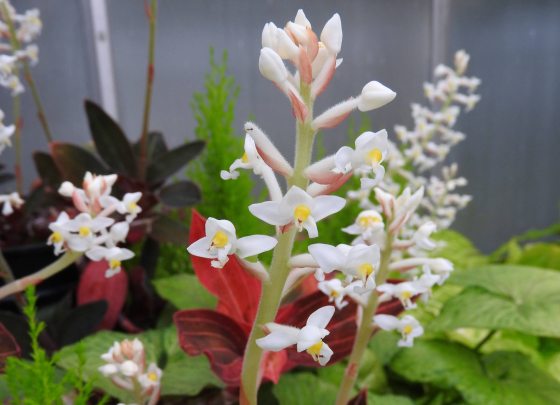
Jewel Orchids (Ludisia discolor)
Jewel orchid is a common term that refers to a large grouping of diverse orchids prized not for their flowers, but for their strikingly variegated and patterned foliage. Easily grown as a houseplant, the most common, Ludisia discolor, has pinstriped leaves and small, white flowers. Some jewel orchids feature iridescent veins that sparkle in the sunlight. Some smaller species of jewel orchids are especially popular as terrarium plants.
Collection status: actively collecting
Light: low (500–1000 footcandles)
Temperature: warm (60–80 F)
Water: evenly moist
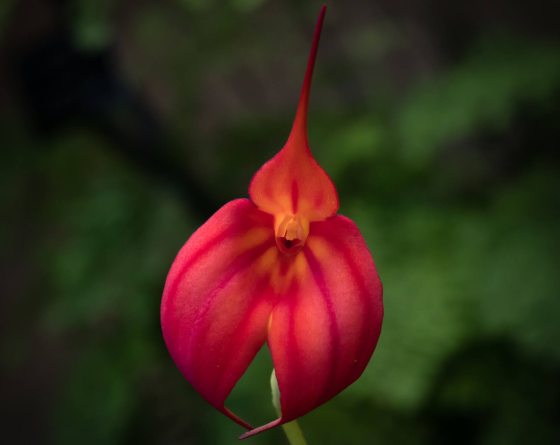
Masdevallia (Masdevallia Gypsy ‘Johnny Angel’)
Native to the cloud forests of Central and South America, Masdevallia flower profusely with blooms characterized by sepals (the outer petals) that unite at their base, sometimes forming a tube that often hides the inner petals and lip. Masdevallia are fast-growing plants that thrive in cool temperatures and high humidity.
Collection status: actively breeding
Light: low (800–1500 footcandles)
Temperature: cool (48–68 F)
Water: evenly moist
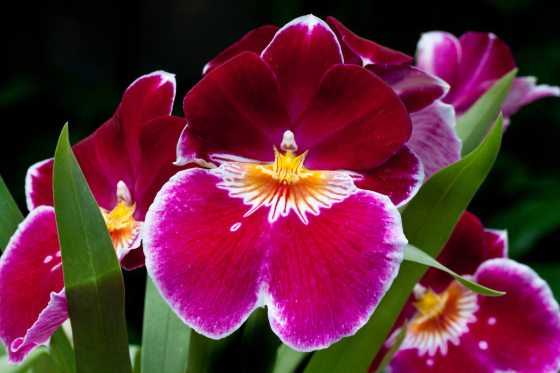
Miltoniopsis (Miltoniopsis Evergreen Joy ‘Mill Valley’)
These orchids carry large, ornately patterned flowers on stems with five to seven blooms. Miltoniopsis grow in cool temperatures across parts of Central and South America. White, yellow, pink, and red flowers have a lip that might feature a cascading waterfall pattern or a small spot of color at its center. You can often experience their sweet, citrus fragrance early in the morning.
Collection status: actively collecting
Light: 1500–2000 footcandles
Temperature: cool (50–75 F)
Water: evenly barely moist
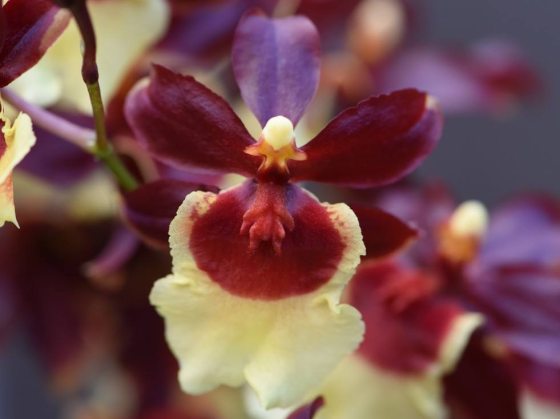
Oncidium (Oncidium Volcano Hula Halau ‘Volcano Queen’)
Native to Central and South America as well as the Caribbean, Oncidium are generally characterized by masses of small- to medium-sized, often-fragrant flowers carried on a branched stem. Oncidium and related tropical orchids hybridize freely to create many intergeneric hybrids in the Oncidium Alliance.
Collection Status: actively breeding, 10% of collection
Light: medium (2000–3000 footcandles)
Temperature: medium (55–75 F)
Water: intermediate

Paphiopedilum (Paphiopedilum General Wavel)
Commonly known as lady’s slipper orchids, Paphiopedilum have a recognizable “pouch,” or modified lip, which they use to achieve pollination. Most Paphiopedilum carry a single flower per stem, varying in size, shape, color, and pattern. The Paphiopedilum on display in the Orchid House are native to tropical Asia. You can find its hardy cousin, Cypripedium, a genus native to North America and parts of Asia, in the Hillside Garden, Peirce’s Woods, and Forest Walk gardens during the spring and summer.
Collection status: actively breeding; 15% of collection
Light: low–medium (800–500 footcandles)
Temperature: warm (60–80 F)
Water: evenly moist
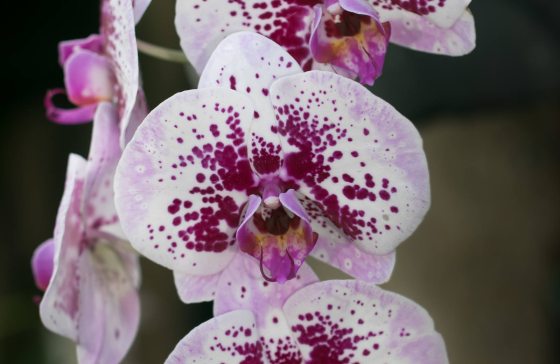
Phalaenopsis (Phalaenopsis Pink Bubbles)
One of the most recognizable orchids today, Phalaenopsis, commonly known as moth orchids, feature wide flat flowers that can last three or more months. Phalaenopsis were first collected from South Asia in the mid-19th century and were typically grown in greenhouses and conservatories. By the 1970s new advances in tissue culturing led to the wide availability of this stunning orchid and new hybridization techniques have produced an endless array of colors and forms.
Collection status: 3% of collection
Light: low (800–1500 footcandles)
Temperature: warm (60–80 F)
Water: evenly moist

Vanda (Vanda Sansai Blue)
Vanda is an epiphytic genus native to tropical and subtropical Asia and Australia. With large, brightly colored flowers, strap-like leaves, and roots that like plenty of air, Vanda is a favorite for hanging basket culture. A standout of the genus is Vanda coerulea, whose pale lavender flowers have generated several blue-flowered breeding lines.
Collection status: 2% of collection
Light: high (3500–4500 footcandles)
Temperature: warm–hot (60–85 F)
Water: intermediate